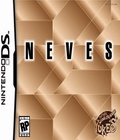Genre: Puzzle
Publisher: Atlus
Developer: Yuke's
Release Date: November 2007
Way back, when we were still grunting knuckle-draggers living in natural caves and spitting vegetable paints over our hands to make silhouette markings on the walls for decoration, we had exactly one trait that separated us from the animals that ate us whenever possible. That trait was the inherent drive to solve puzzles. One can argue that the sum totality of mankind as the dominant species on Earth is our collection of solved challenges. We need to be warm when the weather is inclement. Solution? Fire. We need to cover Fred's Neanderthal back hair, as it's scary to look at. Solution? Cured animal skins to hide our shame. We need a way to communicate over long distances. Solution? Long bits of string and empty soup cans. As a species, we love to figure out puzzles. This is reflected in our enduring infatuation with problem-solving games, too. Well folks, let me tell you, the title I have in my hands right now, due to be released in November of 2007, tickles that primeval urge to sort things out in all the right ways. You might want to tack a post-it note to your nearest calendar because Neves is coming soon and will eat all of your free time.
Produced by an Osaka-based development team known as Yuke's Future Media Creators, the design of Neves springs from a company with a great deal of history in this particular field. Hanayama Games was founded in 1933, and for all this time has been cooking up new brain-teaser metal puzzle toys. Not many companies can last that long, and it's a safe bet that their skill in this field must be refined to a razor's edge to keep the business afloat for 70 years. Now imagine their experience and logic acumen being brought to the NDS. That's what Neves is: two great tastes that taste great together.
The basic idea is that you're given a blocky shape that needs to be filled in. You also have a limited number of blocks that can be configured in such a way that they fill up the silhouette. The puzzle is in how to make those blocks work within the confines of the shape in front of you. Trust me when I say that it sounds much simpler than it is. It took me about 15 minutes to sort out the second shape. All I could think was, "This is only the second one, and it took me this long?!" I didn't feel entirely intelligent after that.
Neves is played out pretty much entirely on the bottom screen of the DS, with the top screen only coming into play during multiplayer head-to-head matches. The entire control scheme is stylus-based, so you basically click and drag. All of the shapes can be manipulated in several ways: touch once to select; tap twice to flip the block over; tap and hold any of the corners to move clock- or counterclock-wise to any angle you need; and tap, hold and drag to move the block anywhere you need it to go. The input is extremely simple, leaving more time to sort out the puzzle itself.
There are three single-player modes, as well as the aforementioned multiplayer. Most puzzle action will probably take place in the Silhouette mode, where there is effectively no way to lose. This is a huge series of shapes that need to be filled in, with no limits as to how long you take. Next up is Time Pressure mode, where you only get three minutes to sort out the challenge. I personally haven't gotten to the point where I'm willing to try this. Finally, there is the 7 Steps mode. There is no time limit here, but you have to solve the puzzle in seven moves or less. Mistakes are not an option — there are seven blocks to place, so each move must be correct, or you lose.
Multiplayer is simple enough. Using the NDS download-and-play function, one person hosts and XXXX joins in. You're both given the same shape to fill in, and the first person to fill in three silhouettes wins. There is a timer running as well, so if you're both slow on the draw (like me and my buddy testing this out at a diner last night), then you both lose. Remember how I said that the top screen comes into play during head-to-head? Well, the upper screen displays your opponent's moves and progress, so technically you can ape whatever they're doing that you haven't figured out yourself. It seems unfair, but remember — it works both ways.
There's no shortage of shapes to sort out, either. Level one of Silhouette mode alone has over 40 challenges in four stages. That's over 40 on each stage, not spread through them all. Time Pressure and 7 Steps both draw from the same list of puzzles, but when you add up the sheer volume and the answer comes to somewhere around 500 different shapes to fill in, it's pretty difficult to accuse the developers of slacking off.
Neves has the distinction of being the first NDS title since I got the handheld in which my wife has expressed any interest. After playing through a couple of the challenges in about half the time it took me to sort out even one, her reaction was simple: "It's a puzzle game," she said with an almost dismissive air of "Why else am I better at it than you are?" Everyone knows women are the real brains on this Earth, but did she have to point it out so bluntly? Of course she did. The point here is that not only is Neves an addictive brain teaser, but it's also gender-neutral in its appeal. This isn't a common achievement for digital games.
Now technically, when doing a preview, a journalist isn't supposed to be judgmental in any way. We're not to point fingers in a dismissive manner, nor are we to praise too heavily any offerings that aren't actually completed. A preview is informative only; it's the reviews that are meant to be influential to the buying public. However, in the case of Neves, it's very difficult to just explain how it works without sounding praiseworthy. Its simplistic elegance shows through no matter how monotonous one makes his descriptive narrative. This game wasn't even on my radar, but it's certainly on my must-have list for the NDS now. As a complete package of entertaining content with near-endless replay value, Neves should be on everyone's must-have list.
More articles about Neves











 NEVES is a puzzle game that challenges players to think critically as they align pieces and build figures that correspond to a silhouette. Each puzzle features 7 wooden blocks, requiring the player to combine them to form specific figures ranging from simple items like a sword or key to more complicated ones such as birds or airplanes.
NEVES is a puzzle game that challenges players to think critically as they align pieces and build figures that correspond to a silhouette. Each puzzle features 7 wooden blocks, requiring the player to combine them to form specific figures ranging from simple items like a sword or key to more complicated ones such as birds or airplanes.














